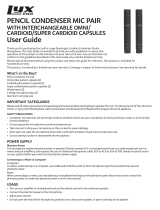
SpeechLine IS microphone series | 1
Contents
Contents
Important safety information ...................................................................... 2
Sennheiser SpeechLine – True to the word ................................................ 3
Typical applications ....................................................................................... 3
Typical ways of setting up and installing microphones ......................... 4
Pick-up patterns of the microphones ........................................................ 6
Positioning the microphones ....................................................................... 6
Typical acoustic situations ........................................................................... 8
Overview of the SpeechLine IS microphone series .................................... 9
Package contents ......................................................................................... 10
Package contents of the microphones | microphone heads ............... 10
Package contents of the
tables stands | floors stands | microphone mounts ............................. 11
Package contents of the inline switch box | microphone button ...... 11
Product overview ......................................................................................... 12
Overview of the MEB 114 (-S) boundary layer microphones ............. 12
Overview of the MEB 102 (-L) | MEB 104 (-L)
surface-mounted boundary layer microphones .................................... 13
Overview of the MEG 14-40 (-L(-II)) gooseneck microphones ........... 13
Overview of the MZH 30xx (-L) goosenecks .......................................... 14
Overview of the MAT 133 (-S) | MAT 153-S table stands ................... 14
Overview of the MAS 133 inline switch box ........................................... 15
Overview of the MAS 1 microphone button ........................................... 15
Overview of the MZFS 60 | MZFS 80 microphone stands .................... 15
Mounting and installing the products ...................................................... 16
Planning the position of surface-mounted products ........................... 16
Mounting surface-mounted boundary layer microphones,
microphone buttons, switch boxes: table | lectern ............................... 18
Mounting the gooseneck microphones: table | lectern | stand .......... 20
Mounting microphones to the ceiling ...................................................... 22
Positioning mobile microphones .............................................................. 25
Connecting the products ............................................................................. 26
Connecting the products to an audio input ............................................ 26
Connecting products via the logic function ............................................ 28
Adjusting and using the products ............................................................. 31
Adjusting the microphone sensitivity ..................................................... 31
Activating/deactivating the low-cut filter on the MEB 114 (-S) ....... 31
Setting the behavior of the microphone button ................................... 32
Activating/muting microphones .............................................................. 33
Cleaning and maintaining the products ................................................... 34
Specifications ............................................................................................... 35
Product specifications ................................................................................. 35
Pin assignment ............................................................................................. 40
Polar diagrams ............................................................................................. 41
Frequency response curves ........................................................................ 43
Manufacturer Declarations ......................................................................... 45























